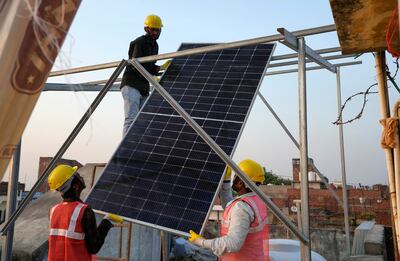The geopolitical and economic instability in the world this past year has exposed the fault lines in the global energy system. Months of uncertainty have threatened to throw the transition to a renewable-based future further off track.
Amid these unfolding challenges, the twin goals of tripling global renewable energy capacity and doubling energy efficiency by 2030, set out in the UAE Consensus, have become more important than ever.
But right now, we are not even close to our targets – as the International Renewable Energy Agency’s (Irena) first report since it was commissioned by the Cop28 UAE Presidency to track the progress of the tripling renewables target makes plain.

By tracking the progress we’ve made and, crucially, identifying the gaps we still need to bridge, Irena’s report on ‘Delivering on the UAE Consensus’ is a wake-up call and a blueprint for the international community.
The numbers reveal a stark reality. Current national plans are only halfway to meeting the renewable energy targets, with a projected global shortfall of 3.8 terawatts (TW) by 2030 looming large, unless we act to close the energy gap now.
Irena’s report lays out the scale of the task ahead. To hit the 11.2-TW goal, we must add 1,044 gigawatts (GW) of renewable power every year – which requires a 16.4 per cent annual growth rate.
Yet, current growth trends show we’re only on track to achieve half that. Despite a record 473 GW of new capacity added in 2023, and the continued robust growth of solar energy solutions, the world needs to triple onshore wind, increase offshore wind six-fold, and scale geothermal capacity 35 times to meet the goal.
And this challenge is not evenly spread. The gap between developed and developing regions is widening. Asia, Europe, and North America account for 85 per cent of global installed capacity, while Africa lags with just 1.6 per cent. If this trend continues, the energy transition will leave vast regions behind.
The are clear roadblocks standing in the way of faster progress. Outdated infrastructure, inadequate financing, and a shortage of skilled workers are slowing the progress of the energy transition. Grid capacity is falling behind, with 3,000 GW of renewable power waiting to be connected.
Policymaking, too, is not evolving fast enough to remove delays, streamline permitting, and incentivise renewable energy capacity building.
The current state and pace of scaling up renewable solutions calls for strong leadership from governments to reform the obstacles currently clogging up regulatory frameworks and removing the barriers that delay renewable projects.
Policymakers must act faster, smarter and take bold steps urgently to address a trifecta of solutions that sit at the centre of the energy transition.
First, infrastructure must be modernised. It’s no longer enough to plan – grids need to be expanded, digitised and equipped to handle larger volumes of variable renewable energy. Storage solutions must also be accelerated, with battery storage capacity needing a four to ten-fold increase by 2030 to keep pace with the expansion of renewables.
Second, financing needs to scale up. Irena’s report it makes clear that we’re falling short by a long way. The world needs $1.5 trillion annually in renewable investments by 2030. But last year, only $570 billion was invested. And that funding is unevenly distributed: 84 per cent went to just three regions: China, the EU and the US. Emerging economies, especially in the global south, need better access to concessional finance and grants to fund their energy transitions. Without this, the transition will remain uneven, and the 1.5°C goal will slip further out of reach.
Third, we must develop the human capital capable of powering this energy transformation. The energy transition will create millions of jobs, but only if we invest in education and training. Countries must prioritise upskilling and reskilling workers, developing technical expertise, and empowering the next generation of energy leaders. If we fail to do so, the lack of a skilled workforce will become a bottleneck to progress.
The next six years are critical. The decisions we make today will determine whether we meet the UAE Consensus goals or fall further behind in our mission to deliver a climate resilient, energy secure future.
We have a clear roadmap, but it’s time to accelerate. As the world heads towards Cop29 in Azerbaijan, there is no room for hesitation. We need bold leadership, swift action and unyielding commitment from every corner of the world.
Governments must lead by example. They must raise their ambitions, align their energy plans with the tripling target and put renewable energy at the heart of policymaking. The global community must come together, support those most vulnerable, and ensure that no country is left behind.
We know what needs to be done. The path is clear. But the window of opportunity is closing. The future of our planet depends on whether we act now. We cannot afford to wait any longer.



